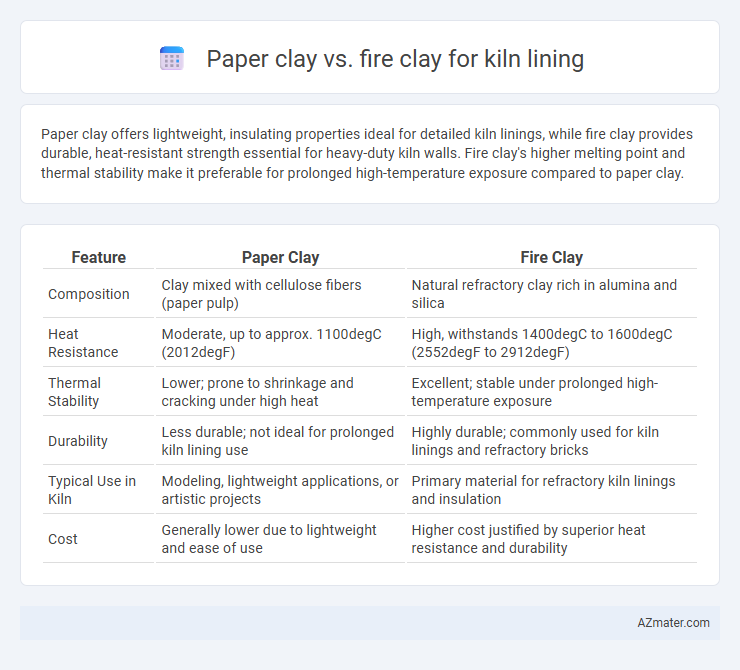Paper clay offers lightweight, insulating properties ideal for detailed kiln linings, while fire clay provides durable, heat-resistant strength essential for heavy-duty kiln walls. Fire clay's higher melting point and thermal stability make it preferable for prolonged high-temperature exposure compared to paper clay.
Table of Comparison
| Feature | Paper Clay | Fire Clay |
|---|---|---|
| Composition | Clay mixed with cellulose fibers (paper pulp) | Natural refractory clay rich in alumina and silica |
| Heat Resistance | Moderate, up to approx. 1100degC (2012degF) | High, withstands 1400degC to 1600degC (2552degF to 2912degF) |
| Thermal Stability | Lower; prone to shrinkage and cracking under high heat | Excellent; stable under prolonged high-temperature exposure |
| Durability | Less durable; not ideal for prolonged kiln lining use | Highly durable; commonly used for kiln linings and refractory bricks |
| Typical Use in Kiln | Modeling, lightweight applications, or artistic projects | Primary material for refractory kiln linings and insulation |
| Cost | Generally lower due to lightweight and ease of use | Higher cost justified by superior heat resistance and durability |
Introduction to Kiln Lining Materials
Kiln lining materials must withstand high temperatures and thermal shock during firing processes. Paper clay, composed of refined paper pulp and clay, provides lightweight insulation with improved flexibility and reduced cracking risk. Fire clay, a dense, refractory material, excels in thermal resistance and durability, making it ideal for heavy-duty kiln linings exposed to extreme heat.
Understanding Paper Clay and Fire Clay
Paper clay, a lightweight material composed of clay mixed with cellulose fiber, offers enhanced green strength and reduced cracking during drying, making it ideal for intricate kiln lining repairs where flexibility is crucial. Fire clay, a naturally occurring refractory clay containing high alumina content and excellent thermal resistance, is traditionally favored for kiln lining due to its ability to withstand prolonged exposure to high temperatures without deformation. Understanding the distinct compositions and thermal properties of paper clay and fire clay helps optimize kiln lining durability, balancing ease of application with heat resistance requirements.
Material Composition and Properties
Paper clay consists of fine clay particles mixed with cellulose fibers, enhancing its flexibility and reducing shrinkage during drying, making it suitable for intricate kiln lining shapes. Fire clay is composed primarily of kaolinite and other refractory clays with high alumina content, offering excellent heat resistance and structural stability at temperatures above 1500degC. The fibrous nature of paper clay improves crack resistance but offers lower thermal resistance compared to fire clay, which is preferred for high-temperature kiln linings due to its durability and thermal mass.
Thermal Resistance: Paper Clay vs Fire Clay
Fire clay exhibits superior thermal resistance compared to paper clay, making it ideal for kiln linings exposed to high temperatures above 1400degC. Paper clay, while lightweight and easier to mold, typically withstands temperatures up to 1000degC, limiting its use in extreme heat conditions. The high alumina and silica content in fire clay enhances its thermal stability and durability, essential for maintaining kiln integrity during prolonged firing cycles.
Durability and Longevity in Kiln Environments
Paper clay offers improved crack resistance due to its fiber reinforcement but lacks the high-temperature durability of fire clay, which is specifically formulated for kiln linings. Fire clay demonstrates superior thermal shock resistance and maintains structural integrity under repeated heating cycles, ensuring longer lifespan in kiln environments. Kiln linings made from fire clay withstand abrasive wear and chemical attacks better, resulting in extended durability compared to paper clay alternatives.
Installation Process and Ease of Use
Paper clay offers enhanced workability and flexibility during installation for kiln lining, allowing easier shaping and joining compared to fire clay. Fire clay, while more rigid and durable, requires precise handling and often more skill to avoid cracking or improper sealing. The ease of use of paper clay reduces installation time and minimizes adjustments, making it suitable for complex kiln designs, whereas fire clay demands careful curing and firing procedures to ensure structural integrity.
Cost Comparison and Availability
Paper clay offers a lower cost alternative to fire clay for kiln lining, primarily due to its reduced material density and manufacturing efficiency. Fire clay, abundant and widely sourced, tends to have stable pricing but incurs higher transportation costs because of its heavier weight. While paper clay's availability may be limited to specialized suppliers, fire clay benefits from broader accessibility in local markets, impacting overall cost-effectiveness depending on the kiln size and regional supply.
Environmental Impact and Sustainability
Paper clay, comprised of recycled cellulose fibers and clay, offers a lower environmental impact than fire clay by reducing raw material extraction and enhancing energy efficiency in kiln lining due to its lightweight and insulating properties. Fire clay, a natural refractory material, demands intensive mining and processing, contributing to higher carbon emissions and resource depletion. Choosing paper clay for kiln lining supports sustainability by minimizing waste and promoting the reuse of materials, while maintaining effective thermal resistance.
Practical Applications: When to Choose Each
Paper clay is ideal for kiln linings in applications requiring easy shaping, repairing, or sculpting irregular surfaces due to its lightweight and flexible nature. Fire clay, with its high refractory properties and durability, is preferred for high-temperature zones and permanent kiln structures exposed to intense thermal stress. Selecting paper clay suits maintenance and custom designs, while fire clay ensures long-lasting lining in industrial or heavy-use kilns.
Conclusion: Which Clay is Best for Kiln Lining?
Fire clay is generally preferred for kiln lining due to its superior refractory properties, high melting point, and durability under intense heat, making it ideal for sustained high-temperature environments. Paper clay, although lightweight and crack-resistant, lacks the thermal stability necessary for prolonged exposure to kiln temperatures. Therefore, fire clay is the best choice for kiln lining, ensuring longevity and efficient thermal insulation.

Infographic: Paper clay vs Fire clay for Kiln lining
 azmater.com
azmater.com